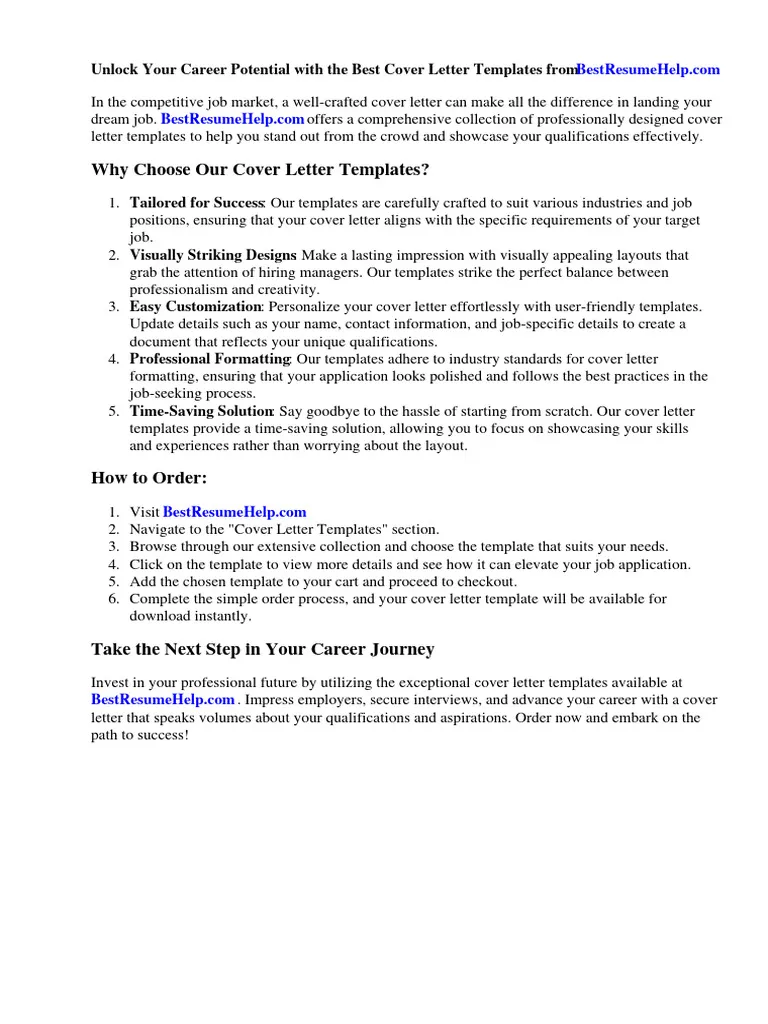What is a Cover Letter
A cover letter is a one-page document that you submit as part of your job application alongside your resume. It serves as an introduction to your qualifications and expresses your interest in a specific position or company. It provides a more personal and detailed view of your skills, experiences, and motivations than your resume can offer. Think of it as your chance to make a strong first impression and persuade the hiring manager that you’re the right fit for the role. For college graduates, a well-crafted cover letter is especially critical, as it provides an opportunity to showcase skills and experiences that may be limited in a resume, such as internships, projects, or volunteer work.
Why Cover Letters Are Important
Cover letters are vital in the job application process for several reasons. Firstly, they provide context to your resume, allowing you to explain gaps in your experience or highlight specific skills that align with the job requirements. Secondly, they demonstrate your communication skills and writing ability, which are essential in most professional roles. A well-written cover letter shows that you can articulate your thoughts clearly and concisely. Thirdly, it allows you to express your enthusiasm for the position and the company, showing that you’ve done your research and are genuinely interested in the opportunity. Finally, it gives you the chance to personalize your application and stand out from other candidates. Without a cover letter, you may be viewed as less serious about the position, making it difficult to get noticed.
Key Elements of a Cover Letter
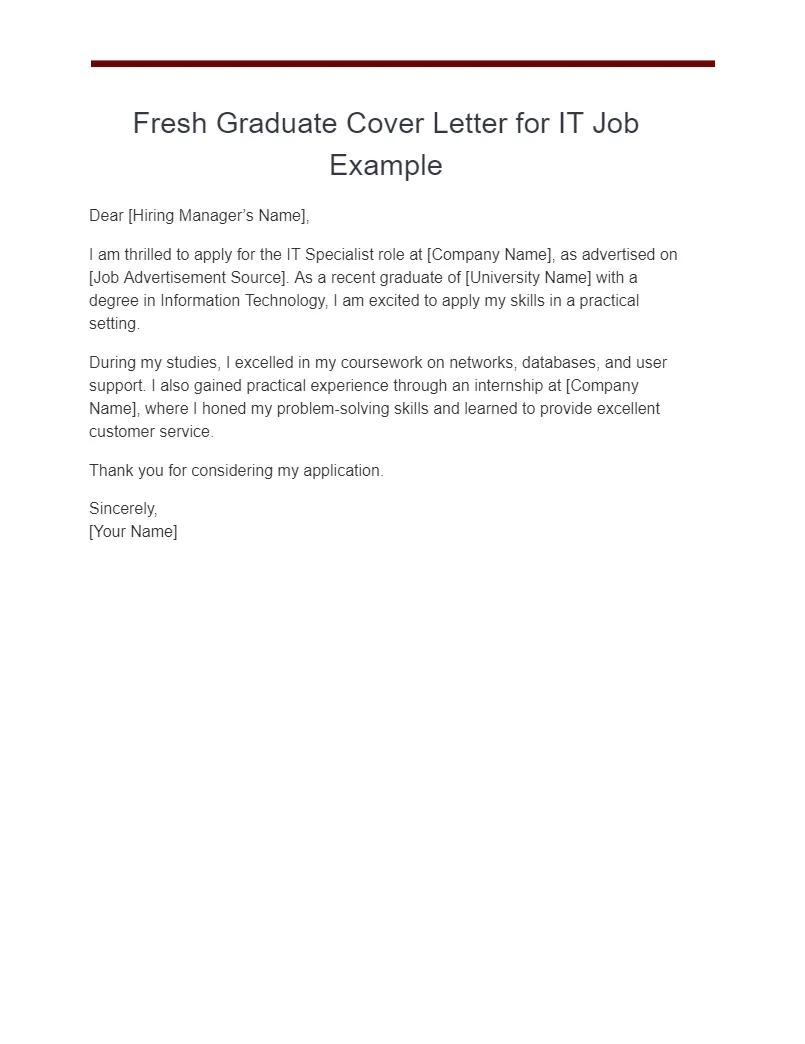
A strong cover letter follows a standard structure, ensuring clarity and impact. Each part plays a critical role in presenting you effectively. This includes the header, greeting, opening paragraph, body paragraphs, and closing paragraph. Each section must be tailored for the specific job and company, demonstrating your understanding of their needs and your ability to meet them. Careful attention to these elements creates a compelling narrative that highlights your relevant skills and experiences, making it clear why you’re the ideal candidate. A well-structured cover letter is not just a formality, it is a strategic tool that can significantly increase your chances of securing an interview.
Header
The header of your cover letter should include your contact information, such as your name, address, phone number, and email address. This information should be clearly visible and easy to find. Some people also choose to include a link to their LinkedIn profile. The header ensures that the hiring manager can easily reach you if they are interested in your application. Using a professional format and font in your header enhances your credibility and presents a polished image. Ensure your email address is professional, and avoid using nicknames or informal language.
Greeting
Begin your cover letter with a professional greeting. Ideally, address the hiring manager by name; this shows that you’ve researched the company and are taking the time to personalize your application. If the hiring manager’s name isn’t available, use a general greeting like “Dear Hiring Manager” or “Dear [Company Name] Team.” Avoid generic greetings such as “To Whom It May Concern,” as they can make your letter seem less engaging. Researching the company’s website or LinkedIn can help you find the right contact person. A personalized greeting sets a positive tone from the beginning.
Opening Paragraph

The opening paragraph is your chance to grab the reader’s attention. State the position you’re applying for and where you saw the job posting. Briefly mention why you’re interested in the role and the company. This should be a concise and compelling introduction that showcases your enthusiasm. Think of this paragraph as your elevator pitch, quickly summarizing your key qualifications and the value you can bring. Keep it short and impactful, setting the stage for the rest of your letter and prompting the hiring manager to keep reading. Demonstrate your understanding of the role’s requirements and what makes you the right fit.
Body Paragraphs
The body paragraphs are where you expand on your qualifications and experiences. Use these paragraphs to highlight relevant skills, quantify your accomplishments, and demonstrate your enthusiasm for the position. Provide specific examples of your achievements and how they relate to the job requirements. Each paragraph should focus on a different aspect of your qualifications. Use the STAR method (Situation, Task, Action, Result) to structure your examples and demonstrate your skills effectively. Showcase your understanding of the company’s needs, and show how you can contribute to their goals. This section is where you demonstrate your value to the employer.
Highlighting Skills & Experience
In your body paragraphs, emphasize the skills and experiences that align with the job description. Identify the key requirements listed in the job posting and then explain how your skills match those needs. Use keywords from the job description to show that you understand what the employer is looking for. Provide specific examples of how you’ve used these skills in the past, whether in internships, projects, or academic settings. This targeted approach shows that you’ve done your research and are a strong candidate. Ensure that the skills you highlight are relevant and that you provide evidence to support your claims.
Quantifying Accomplishments
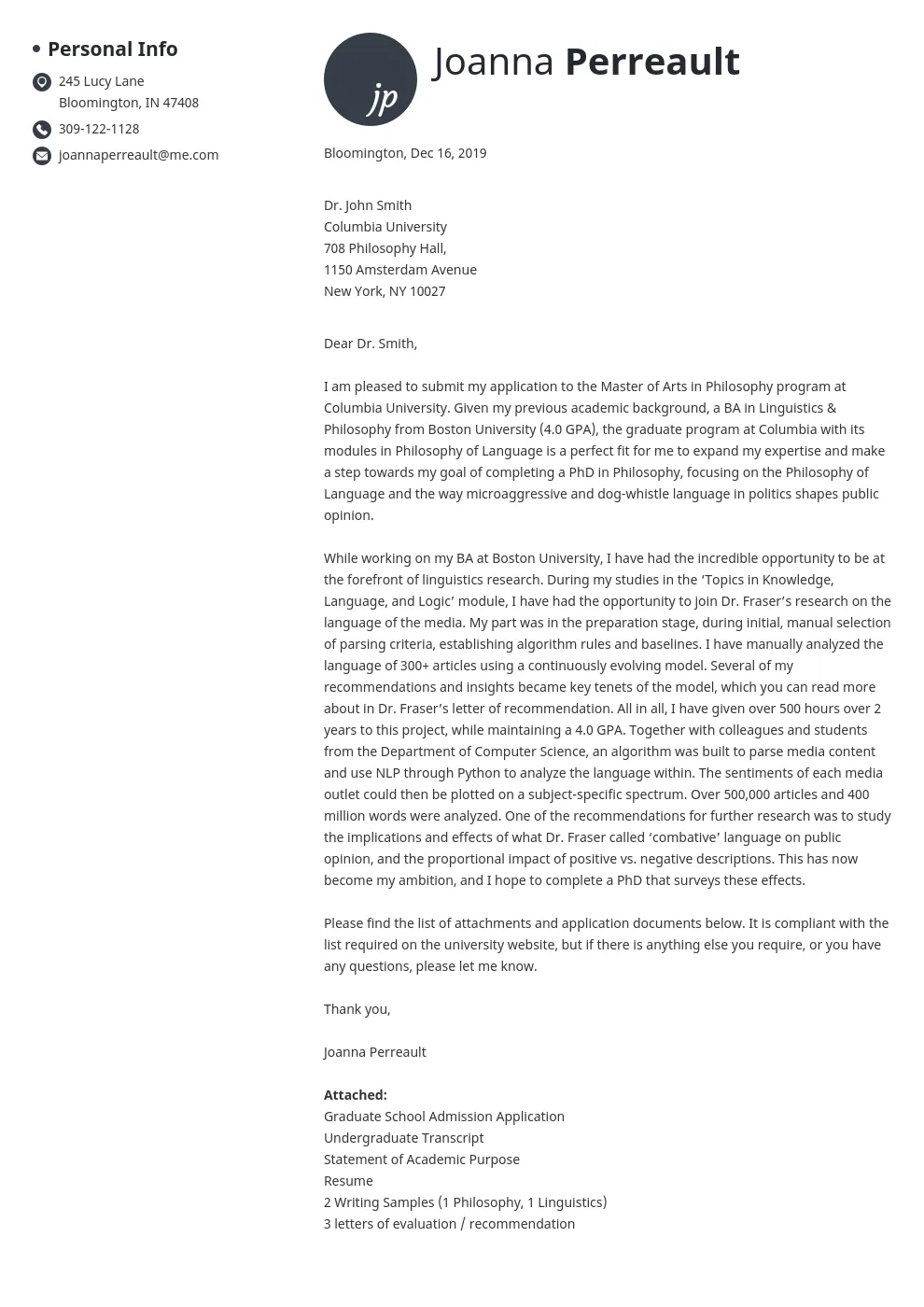
Whenever possible, quantify your accomplishments to demonstrate your impact. Use numbers and data to illustrate your achievements, such as the percentage of sales increase, the number of projects completed, or the amount of money saved. Quantifiable results provide concrete evidence of your capabilities and make your cover letter more persuasive. Instead of saying you “improved customer satisfaction,” state that you “increased customer satisfaction scores by 15%.” Quantifying your achievements shows that you can make a difference, adding value to your potential employer.
Demonstrating Enthusiasm
Show your enthusiasm for the position and the company. Explain what excites you about the role and what you admire about the company’s mission, values, or products. Demonstrate that you’ve done your research and are genuinely interested in the opportunity. Mentioning specific projects or initiatives at the company shows that you’re invested in the culture. Your enthusiasm can make your letter memorable and distinguish you from other applicants. Your passion is contagious and can make a positive impact on the hiring manager, increasing your chances of an interview.
Closing Paragraph
In the closing paragraph, summarize your interest in the position and reiterate your qualifications. Express your gratitude for the reader’s time and consideration. This is also the place to include a call to action, such as stating your availability for an interview. Keep it brief and professional, reinforcing your enthusiasm. A strong closing paragraph leaves a lasting positive impression. This final impression encourages the hiring manager to take the next step. It shows your proactive approach and increases the chances of getting a positive response.
Call to Action
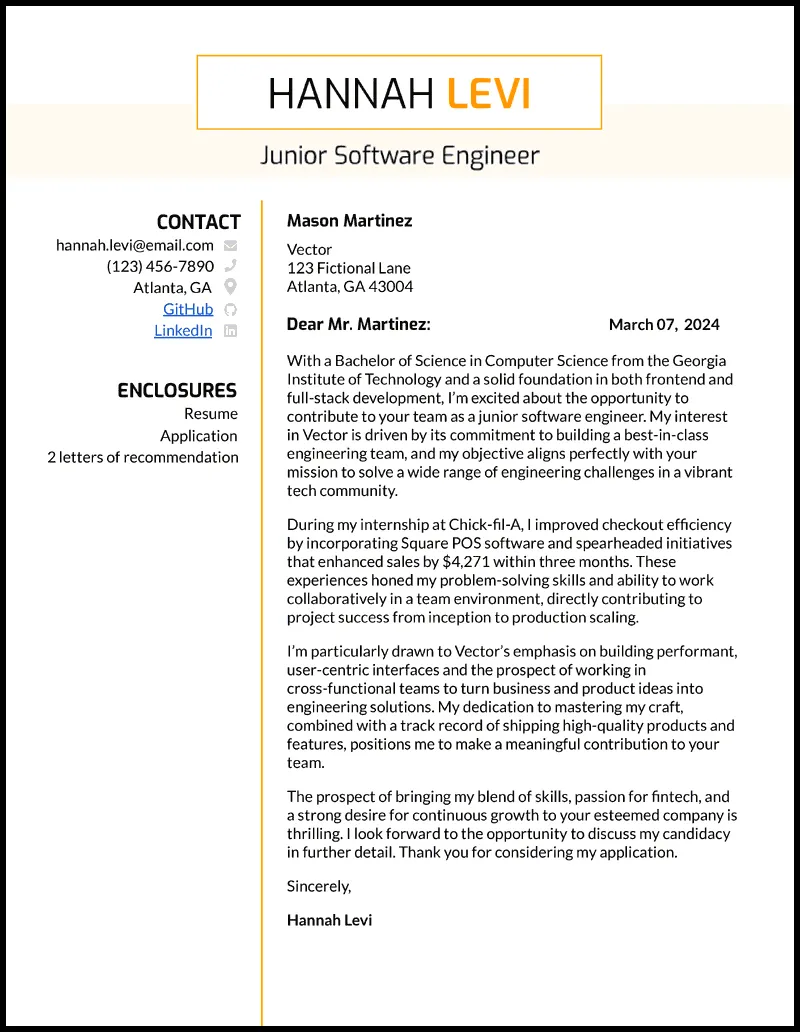
Include a clear call to action in your closing paragraph, such as requesting an interview or expressing your availability. Make it easy for the hiring manager to take the next step by specifying how they should contact you. Reiterate your interest and enthusiasm for the position. A call to action demonstrates your proactive approach and shows you are eager to move forward in the hiring process. It encourages the hiring manager to consider you for an interview. Make sure to provide your contact information again.
Formatting and Design
The formatting and design of your cover letter are essential for readability and professionalism. Ensure your letter is well-organized and easy to read, making it pleasant for the hiring manager. A clean, consistent format reflects your attention to detail and professionalism. Proper formatting increases the chances that your letter will make a positive impression. Choose fonts and layouts that are suitable for business correspondence and easy on the eyes.
Font and Readability
Select a professional font like Times New Roman, Arial, or Calibri for your cover letter. Ensure the font size is between 10 and 12 points for optimal readability. Use clear spacing, and avoid using large blocks of text. Employ bullet points for lists and ensure consistent margins. A well-formatted letter that is easy to read shows you understand professional communication standards. Readability is key to ensure that the hiring manager can quickly grasp the main points of your letter without getting lost in a wall of text. Simple formatting allows the reader to concentrate on your skills and qualifications.
Proofreading and Editing
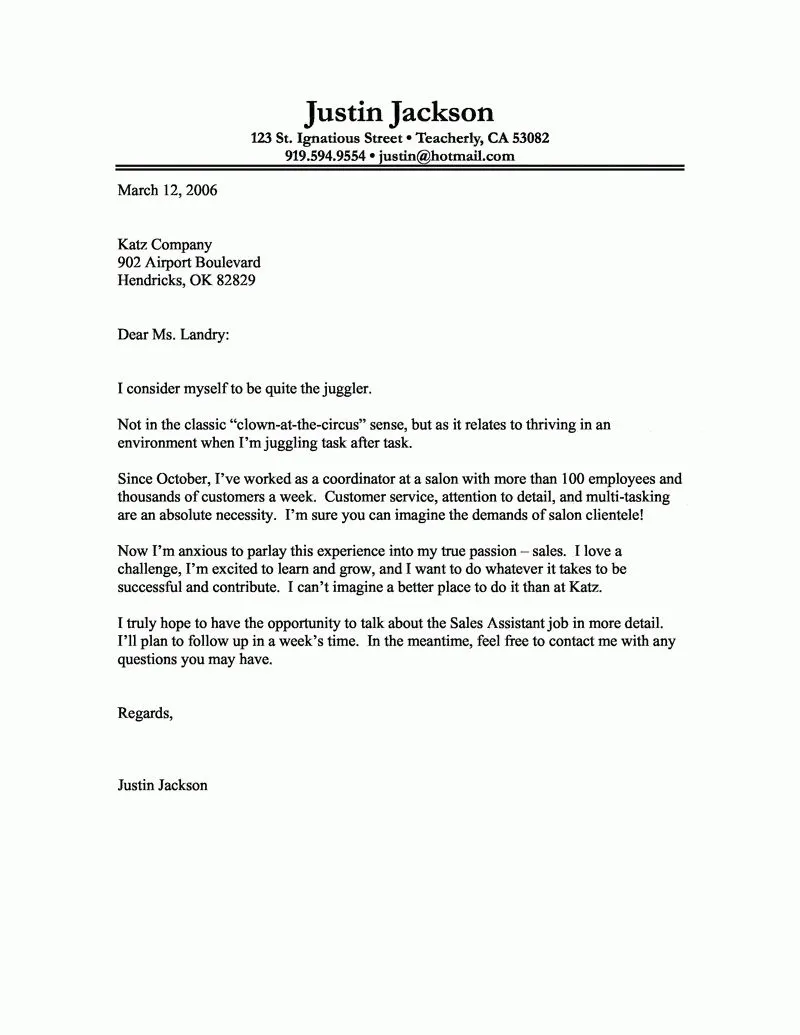
Before submitting your cover letter, proofread and edit it carefully. Check for any grammatical errors, typos, and spelling mistakes. Ask a friend, professor, or career advisor to review your letter for any errors. Ensure your writing is clear, concise, and free of jargon. A polished cover letter demonstrates your attention to detail and professionalism. The presence of errors can make you appear careless or unprofessional, which can negatively impact your application. Take the time to refine your writing and make sure it is error-free to maximize your chances of a positive outcome.
Top 5 Cover Letter Tips for College Grads
To maximize your chances of success, follow these top 5 cover letter tips, specifically for college graduates. College graduates often have limited professional experience, making a well-crafted cover letter crucial. These tips will help you make a strong impression and highlight your potential. The advice addresses common challenges and helps you to stand out from other candidates. By implementing these tips, you can significantly boost your chances of getting your foot in the door for your desired job.
Tailor Your Letter to Each Job
Customize your cover letter for each job application. Do not use a generic template. Read the job description carefully and highlight the skills and experiences that are most relevant to the specific role. Use keywords from the job posting to demonstrate that you understand the requirements. Mention the company’s values or mission. By tailoring your cover letter, you show that you’ve invested time in understanding the position and are a good fit for the company. This personalization makes your application more compelling. This makes your application stand out and boosts your chances of landing an interview.
Showcase Relevant Skills
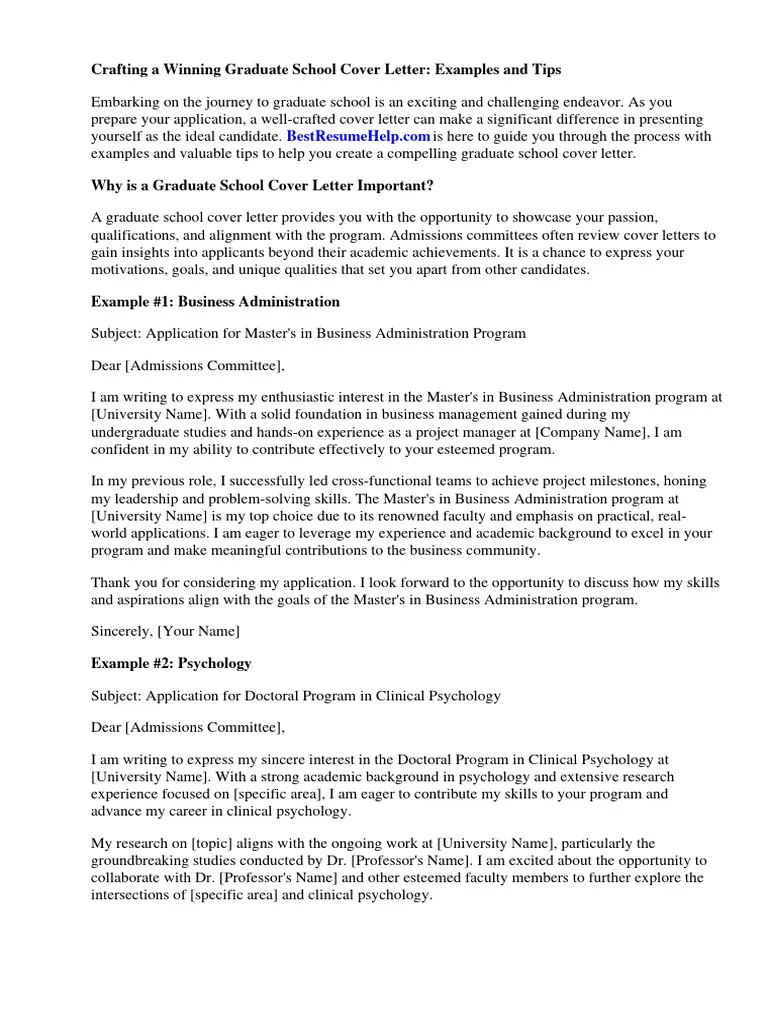
Focus on the skills and experiences that align with the job description. Even if you lack direct work experience, highlight relevant skills gained through internships, projects, coursework, or extracurricular activities. Provide specific examples of how you’ve used these skills to achieve results. For example, if the job requires project management skills, describe a project you led and the outcomes you achieved. Quantify your accomplishments whenever possible. This shows that you have the necessary skills and ability to perform well in the role.
Highlight Achievements Not Just Duties
Instead of simply listing your duties, focus on your achievements and the results you delivered. Use the STAR method to provide specific examples of your accomplishments. For instance, instead of saying you “assisted with marketing campaigns,” describe how you “increased social media engagement by 20%” or “contributed to a 10% rise in leads.” Demonstrating your achievements shows your potential to make a real impact. The focus should be on what you achieved and the positive outcomes that you delivered. Highlighting your achievements makes your application more compelling and shows your ability to make a tangible difference.
Proofread Meticulously
Proofread your cover letter multiple times. Typos and grammatical errors can undermine your credibility and make you appear careless. Ask a friend, career advisor, or professor to review your letter for any mistakes. A polished and error-free cover letter showcases your attention to detail and professionalism. Pay close attention to grammar, spelling, and punctuation. A well-proofread cover letter demonstrates that you value your work and strive for excellence. Double-check the company name and the hiring manager’s name. Make sure you are not reusing the wrong cover letter.
Use Action Verbs
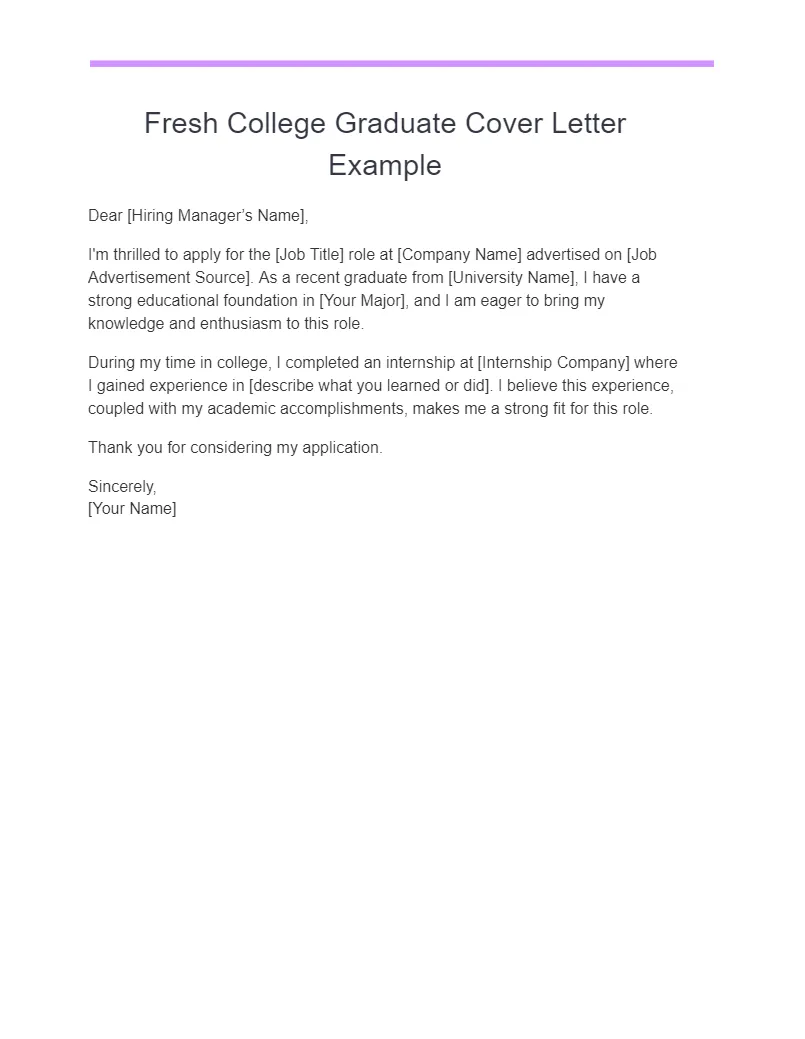
Use strong action verbs to describe your skills and experiences. Action verbs bring your accomplishments to life and make your cover letter more engaging. Instead of using passive phrases like “responsible for,” use active verbs such as “managed,” “led,” “created,” or “developed.” This makes your cover letter more dynamic and shows that you’re a proactive individual. Using a variety of strong action verbs can make your writing more impactful and demonstrate your ability to take initiative. These verbs make your letter more memorable and help to show that you are an active participant.
Cover Letter Examples for College Graduates
Review cover letter examples tailored for college graduates. Look for templates or examples that match your field or the types of roles you’re applying for. Pay attention to how other graduates have highlighted their skills, experiences, and achievements. Adapt these examples to fit your own experiences and the specific requirements of each job. Analyze the structure, language, and tone of the examples to guide your own writing. Use these cover letter examples for college graduates as a guideline to enhance your own cover letter.
